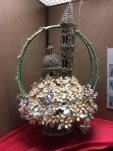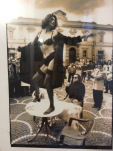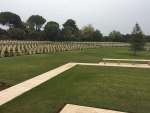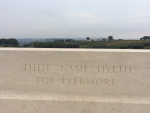Never Forget





Today, October 15th, is the fourth day of our mini-break in Italy, in the Abruzzo region. We have had a brilliant adventure in the mountains, exploring the Gran Sasso region. It was drizzling this morning, after three days of sunshine, but this didn’t dent our moods. We visited Sulmona and toured the Pelino family’s confetti museum and business. Confetti are not the little pieces of paper we Brits scatter over bride and groom at weddings. They are sugar coated almonds given to guests at weddings, Holy Communion breakfasts, Baptisms or Confirmations to commemorate the special day. They can be very elaborate, as in these vintage photos. The same family firm has been making these little sweet fripperies since 1783.
I “borrowed” a photo displayed in the museum to joke that I danced on the tables of the bar where Maurice and I enjoyed a coffee later on. Our mood was light-hearted.
On our way to our next destination, we realised we were about to cross the Sangro river. Memories of a huge Second World War battle stirred in our minds and I quickly googled for the details. A few kilometres away was the English war cemetery and we decided to make a slight diversion to visit. [image error]
I still have a lump in my throat as I write this. What a place. It is the second largest cemetery in Italy administered by the Commonwealth War Graves Commission. There are 2,617 soldiers from the Commonwealth buried here, not including those commemorated in a monument to the 512 Indian soldiers cremated on the site. Their funeral byres were constructed from a wood opposite that was a shelter for the last German soldiers before their final retreat beyond the Sangro river. It is now a Regional Nature Reserve.
Torino di Sangro lies along the Gustav Line which went through Monte Cassino, amongst other places, and was the main defensive line to stop the Allies reaching Germany through mainland Italy between December 1943 and June 1944. In the area we visited, the Germans held the towns around Torino di Sangro and there was particularly fierce fighting between November 27th and 29th 1943. The English 8th Army occupied a steep hill overlooking the Sangro river.
This cemetery includes the remains of 1,768 British, 2 Canadians, 3 Australians, 355 New Zealanders, 74 South Africans, 75 unknown soldiers and 5 from other countries. The graves are arranged like an amphitheatre and the cemetery is surrounded by olive groves, a scattering of farms, and overlooks the river and the sea beyond.



Maurice and I were deeply moved. He found the graves of many, many soldiers from the Artillery of the 8th Army; his own father was part of this Regiment, whilst I couldn’t help thinking of my own childhood in the 1960s in Rome. My father was deputy head in those years of the Commonwealth War Graves Commission for Europe and North Africa and, as children, we were taken to visit many of these cemeteries. All of them beautifully kept, oases of peace, places of dignity, each grave tended carefully by respectful gardeners, the lawns always immaculate, even in sun-drenched countries.
I walked around the graves of these young people, feeling unbearably sad as I read the inscriptions. Here are only a few:
“In memory of XXX. God bless you, dear. You are not forgotten. Mother-in-law and family.”
“A silent grief, but God knows best.”
“No day dawns, no night returns, but we remember you.”
“Gone from our home, but not from our hearts.”
“God’s greatest gift, remembrance. Mother.”
We drove away in silence. And I thought about our morning, when we’d laughed over stupid things and enjoyed carefree hours. Many of the young men who are buried in Torino di Sangro were in their early twenties and thirties. We should never forget the sacrifice they made for our freedom, nearly 75 years ago.
[image error]



